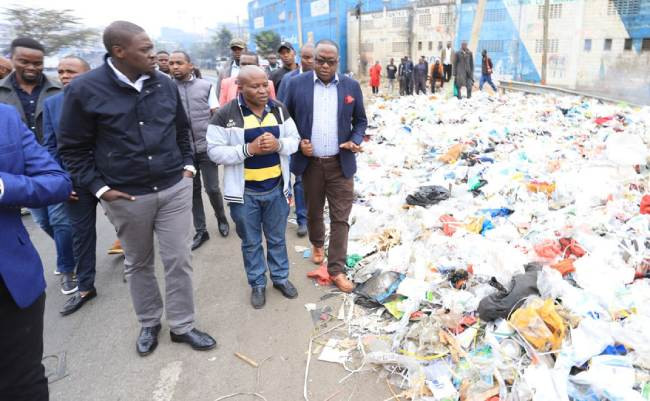Are Nairobi city residents getting a raw deal from Governor Johnson Sakaja or are they being unfair in their assessment of the county boss?
Many of those interviewed answered in the affirmative to the former, accusing Sakaja's administration of failing to deliver on his campaign promises. They said their expectations were high and do not understand why Sakaja is taking long to transform the city whose roads remain pathetic, public transport is in chaos, hawking has run out of control and garbage is an eyesore.
Yet on the campaign trail, Sakaja, through his 'Let's make Nairobi work' clarion call, promised to fix these problems.
"My verdict is that he has failed. And I am blaming the media for not exposing and highlighting Sakaja's failures," says Waithera Chege, Nairobi South MCA who in the recent past has been at the forefront critiquing his administration.

According to Waithera, during their campaign, Sakaja's priorities were good roads, dignified affordable housing, clean water, street lighting, traffic de-congestion, improved health services, efficient public transport and a conducive environment for a thriving business community.
"One year down the line, the question is: have we lived up to the promises we made to our people? What tangible deliverables can we show? While we appreciate the policies that Governor Sakaja has been initiating, we must ask ourselves; do the policies have an immediate positive impact on our people? As members of the county assembly, have we provided the necessary support to the governor and to what extent?" she posed.
Waithera went ahead to identify some of the issues stopping the executive and assembly from delivering key among them being a complacent assembly that is neither asking the hard questions nor pushing the government agenda fully.
Others are poor or delays in resourcing of assembly activities, lack of meaningful legislative output, a disconnect between the executive priorities and the realities on the ground, and delays in the implementation of projects especially Ward Development Programme projects.
"We implore on the governor to take personal interest and ensure that projects are procured on time, implemented and contractors who complete their tasks are paid. This is the only way to realise development," she said.
The ward rep captured the mood on the ground where residents are disappointed with the lip service delivery they are getting from City Hall.
Anti-climax
Shadrack Mugendi Mutiga, a matatu driver, says what players in the transport sector are witnessing is an anti-climax of their initially high expectations.
The 42-year-old father of four says as a resident, he finds nothing to be proud of about Sakaja's government after more than one year in office.
"He has failed us; many roads are potholed, water rationing continues, hospitals have no medicine, drainage systems have collapsed while the askaris are obsessed with taking bribes from traders," laments Mugendi.
However, all is not lost and it is not too late for the governor to redeem himself, according to Kenya Alliance of Resident Associations (Kara) Chief Executive Officer Henry Ochieng, who thinks there is still room for adjustment and improvement.
The governor, says Ochieng, has done well on El Nino preparedness and in improving health facilities in informal settlements.
"He has done about 50 per cent of what he promised; expectations were high, he, therefore, needs to work harder to meet these expectations," says Ochieng.
The Kara boss says members have been expressing their frustrations about how Sakaja is inaccessible adding that sufficient water supply remains a major challenge in the city.
"Of interest to us as Kara, we expected to have a more robust and structured engagement with key stakeholders. There is need for improvement on this aspect," notes Ochieng.
The frustrations are understandable because nothing much has changed in a city where life is a nightmare due to poor infrastructure, inadequate social amenities and dilapidated facilities.
Proper planning
The governor promised to turn the city into a paradise of order, dignity, hope, and opportunity.
But there are no signs of transformation - many roads are potholed, matatu crews break the law with abandon, hawkers have taken over streets and pavements, and garbage litter everywhere.

Mairura Omwenga, an urban planner, thinks that addressing these problems requires proper planning but not the usual piecemeal and ad hoc approach preferred by politicians.
"When we fail to plan, then we are planning to fail. When we make promises that are not anchored on tangible development plans; nothing much can be achieved. And this is the situation we find ourselves in regarding the status of our city," explains Omwenga, who is the chairman of the Town and County Planners Association of Kenya (TCPAK).
While optimistic that Sakaja can transform the city, Omwenga says the governor needs to stick to the integrated development plan that provides a clear framework on how the city should be developed progressively.
"He then needs to come up with a sectoral development plan, which outlines the functions of the various sectors and how they are linked to the integrated development plan. It's a whole network and no sector can function on its own," he added.
Perhaps the current development inertia is because of Sakaja underestimating the task ahead. Other than the school feeding programme, it is almost impossible to pinpoint the governor's other achievements despite having pledged to deliver where his predecessors failed.
The governor recently dismissed his critics of living in denial when it was obvious that he had scored on various fronts.
"I see such ratings and laugh. Who did the ranking and what were the metrics? Nairobi has collected the highest revenue in 5 years, paid 7,640 Community Health Volunteers (CHVs) monthly from August last year, and built its first ICU, 2nd renal unit, 1st NICU ever," Sakaja wrote on his X, formerly Twitter, account in September while reacting to an opinion poll ranked him among the worst performing governors.
He went ahead to defend his development track record, insisting he had achieved a lot within a span of one year. The opinion poll was conducted by Insight Strategists Solutions (ISS) Africa.
Top performers
"We have employed 2,500 Green Army, built 10 kitchens to feed 250,000 children, and some 88,000 children are on-boarded already. My administration has tarmacked roads, put up street lights, issued bursaries and scholarships worth Sh1 billion in one year compared to Sh3 billion in 10 years," said Sakaja.

By the time of going to press, the governor had not responded to our text message about concerns raised by residents regarding his development agenda. Neither did he pick calls.
When Infotrak Research and Consulting recently released its ranking, Sakaja was not among the top performers.
Trans Nzoia governor George Natembeya and his Homa Bay counterpart Gladys Wanga were named the best-performing governors in the country. The two emerged top in a list of top 25 governors, scoring an average of 70 per cent each.
In the ranking, West Pokot Governor Simon Kachapin came in third with 67 per cent while Simba Arati (Kisii), Irungu Kang'ata (Murang'a), Jeremiah Lomurkai (Turkana) and Mutula Kilonzo (Makueni) tied at position four with 64 per cent.
Wesley Rotich (Elgeyo Marakwet), Kawira Mwangaza (Meru) and Julius Malombe (Kitui) ranked eighth with 63 per cent. Cecily Mbarire (Embu) and Patrick Olentuntu (Narok) tied at 62 per cent.
The counties were rated on twelve core functions: agriculture; health; education; roads and transport; energy; water management, environment and natural resources management; trade and tourism; county planning and development; housing, lands and settlement; culture, sports and social services; and public participation, planning, and management of county resources.
In his campaign manifesto titled 'Let's Make Nairobi work', Sakaja promised to transform the city identifying Order, Dignity and Opportunity as the pillars of his transformation agenda.
Residents were told that a city of order will entail providing healthy lunches for all learners in public primary schools, decentralising the city into five boroughs for focused service delivery for citizens, creating a working Universal Health Care (UHC) and having efficient mobility.
School feeding programme
Although it has been met with resistance, a significant number of learners have benefitted from the feeding programme launched in June.
Apart from a court case being filed in court opposing the manner in which the Sh1.2 billion programme was implemented, there were murmurs of complaints from many parents that food either arrived later or was never delivered at all - concerns Sakaja dismissed as propaganda.
In a statement on September 18, the county boss maintained that the programme was right on the right course.

"A few people are against our feeding program for nefarious reasons. Resorting to propaganda won't work. Using children for politics won't work. The first phase of schools onboarded have been getting their hot meals daily and on time. All head teachers have communication to continue with their arrangements until the county communicates once the next phase begins," Sakaja stated. He added in the statement that at least 80,000 students are enjoying daily meals in the phased implementation.
Decentralizing Nairobi
On efficient mobility, transport remains a major problem manifest in the chaotic matatu industry, motor vehicle congestion in the CBD, permanent gridlocks, disorderly boda boda riders, unruly cart pushers and trolley pullers.
The plan to decentralise the city into boroughs remains just a promise. There is no sign of the city being divided into North, East, West, South and Central administration blocks to ensure ease of access to public services and management as had been promised by Sakaja.
The initial promise to prioritise UHC seem to have run into headwinds while the pledge to restore decency in public transport by decongesting the CBD, constructing footpaths, properly covered drainage and building a city metro commuter light rail remain in pipe dream (change) for now.
Residents living in a city of dignity were to have uninterrupted supply of water, affordable and decent housing, and enjoy a clean and green city. Though houses are being constructed by the national government in various parts of the city, most estates experience constant water shortages and the city is stinking in dirty.
Yet Sakaja on the campaign trail promised to introduce e-waste handling and disposal of waste. Many of the residential and commercial places are being choked by heaps of garbage.
The pillar of opportunity was to focus on small-scale trade. In the manifesto, 20 new markets were to be constructed to accommodate hawkers. Unfortunately, this has not been achieved and hawkers flock into the CBD for opportunities.
The resident interviewed expressed their disappointment with Sakaja's administration, which they said had failed on almost all the campaign pledges made.
"Does the governor really care about the plight of city residents?" posed Nelson Githaiga, chairman, Muthurwa Traders Association while decrying the deplorable environment at the market where there is no sufficient water, sewer system has collapsed, garbage goes uncollected for days and matatu terminus is dilapidated.
Githaiga accused Sakaja's administration of being detached from traders' pressing needs. "There is nothing he has done for us. His administration is only focused on collecting and increasing levies but not offering services for the revenue collected," he added.
 The Standard Group Plc is a multi-media organization with investments in media
platforms spanning newspaper print
operations, television, radio broadcasting, digital and online services. The
Standard Group is recognized as a
leading multi-media house in Kenya with a key influence in matters of national and
international interest.
The Standard Group Plc is a multi-media organization with investments in media
platforms spanning newspaper print
operations, television, radio broadcasting, digital and online services. The
Standard Group is recognized as a
leading multi-media house in Kenya with a key influence in matters of national and
international interest.
